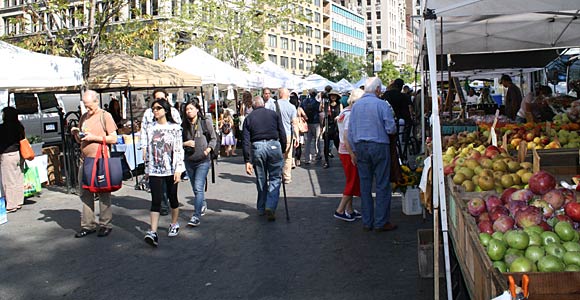

Have you wandered through the farmers' market at Union Square in New York City on a Saturday morning? One visit and you can feel the excitement surrounding the local food movement. The energy is palpable watching hundreds of people bustling around stand after stand of upstate farmers' healthy, fresh food. Even in the dead of winter, treasures are on display from local farms. And the community of local foodies and farmers is vibrant.
I don't remember farmers' markets all over the city when I was growing up. What has changed and how can I help support this trend?
I recently spoke with Seth McKee, director of Land Conservation at Scenic Hudson, to help understand what has brought about this revitalization of the farmers' market and to find out more information on how Scenic Hudson has been helping to protect farms in the Hudson Valley.
Is it just me, or does it seem like farmers' markets are popping up everywhere?
Seth: Yes, it's true. According to the USDA, as of mid-2010 there were 6,132 farmers markets operating throughout the U.S., which represents a 16-percent increase from 2009. New York State alone has over 450 markets. We have seen a similar trend all through the Hudson Valley. Farmers are doing a lot more direct marketing. They are realizing that it is worth their time to go to markets and sell directly to customers. Traditionally farmers sold their goods into the wholesale market or to brokers who would sell the products all over the country and, in some cases, even globally. However, selling directly to customers eliminates the "middle man" and can be good for business.
Why do you think people are spending more time in farmers' markets?
Seth: There are probably many factors that go into these changes in consumer decision-making. I think things shifted in the second half of the 20th century, when the industrialization of the food industry really took off. That's when we started to see massive supermarkets and the growth in the packaged food industry. The result was that people became detached from farms and local food. But in the last 10 years or so it seems people are becoming more aware of the health benefits of eating fresh food that is locally grown rather than preserved on a shelf. Also people are concerned about food safety in general. They want to know where their food is grown and who is growing it. In addition people are much more tuned in to the variation in taste when something is picked from a vine and sold locally versus something that is picked, put on a plane and shipped from far away.
How does Scenic Hudson get involved in saving farmland?
Seth: Check out the timeline on our website, which has an overview of what we have done for the past 15-plus years. We have long-established relationships with farmers, towns and counties throughout the region and various land trusts and conservation groups, and we are constantly working to develop new projects that will safeguard productive farmland in perpetuity. We have some exciting projects in the works right now. We are presently working in partnership with nine farmers, the Dutchess Land Conservancy and the Town of Red Hook to purchase the development rights to nine farms in the Kerley Corners corridor of Red Hook, Dutchess County. Listen to what Jerry Simonetty has to say about working with Scenic Hudson in our A Growing Legacy video.
Are more young people getting involved in farming?
Seth: According to the recently released Glynwood Center 2010 report, the average age of farmers in the Hudson Valley was 57 years old in 2007, up from 55 years old in 2002. But the report also points out that there has been an increase in the number of farmers under the age of 25. Conservation easements can lower the cost of farmland and make it attainable for younger farmers to purchase and secure their future in farming.
How can people get involved and support this trend?
Seth: "Agritainment" and "agritourism" have become more popular. From frequenting farmers' markets, buying local food in the supermarkets, visiting pumpkin patches to u-pick orchards to Christmas tree farms, people are seeking out connections with their local farms. Some farms in our region, like Hull-O Farm in the Northern Catskills, even offer family farm adventures, where your family can stay on the farm and partake in daily chores like hand milking cows and goats to feeding the pigs and picking the eggs.
So whether you are ready to go vacation on a farm or just interested in buying your dinner at a farmers' market, there are lots of ways to support this trend. Talk to the local farmer next time you are at the market, ask about the farm and the land. Learn about the food that they are growing and this best ways to cook it. And don't forget to bring your children and let them explore the bounty. I hope that this trend only keeps on growing and before we know it, we will all be tending our own gardens even if those gardens happen to be on the top of 20-story building.
See you at the farmers' market!